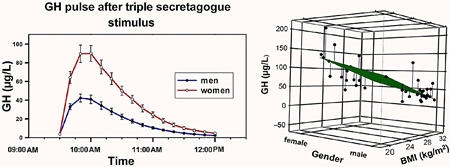ICEECE2012 Poster Presentations Pituitary Clinical (183 abstracts)
GH Secretion response to triple secretagogue stimulus (ghrh, ghrelin and arginine) is gender and BMI dependent in healthy postmenopausal women and older men
C Norman 1 , D Erickson 1 , J Miles 1 , C Bowers 2 & J Veldhuis 1
1Mayo Clinic, Rochester, Minnesota, USA; 2Tulane University, New Orleans, Louisiana, USA.
Objective: Identify predictors of pulsatile GH secretion following a triple secretagogue stimulus (TSS, Ghrelin and GHRH preceded by an infusion of Arginine) in a cohort of healthy postmenopausal women and healthy older men.
Hypothesis: Even in older subjects, total GH secretory capacity is gender dependent.
Design: 23 men and 19 women participated in 6 separate, overnight 16-h infusion sessions at Clinical Research Center. At the end of each visit, all volunteers received TSS infusion (arginine, 30 gm for 30 min IV infusion followed by GHRH and ghrelin boluses, both at 1.0 μg/kg). GH response was monitored by sampling blood (0.75 ml) every 10 min at the start of the arginine infusion and for 2 hours afterwards.
Methods: We used deconvolution analysis to characterize pulsatile GH release after triple secretagogue infusion. We analyzed time to peak, peak GH and GH mass/burst responses in both men and women by multivariate analysis, using baseline GH, gender, BMI, IGF-I, IGFBP1, and IGFBP3 as independent variables (results reported in table as mean±SEM).
Results: Total and peak GH responses to TSS are two-fold greater in women than in men and inversely correlated with BMI in both genders (see figure).
Conclusion: Positive effect of female gender on GH secretion might reflect capability of estrogen to increase synergy between GHRH and Ghrelin and blunt inhibition by somatostatin, possibly via greater inhibitory effect of arginine on somatostatin in women. Negative effect of obesity implies reduced GHRH release and/or heightened somatostatin inhibition. These data are the first to show a major gender effect on total GH secretory capacity.
| Women (n=19) | Men (n=23) | t-test(p-value) | |
| Age (years) | 64±1.4 | 61±1.9 | 0.210 |
| BMI (kg/m2) | 26±0.7 | 28±0.6 | 0.198 |
| Baseline GH (μg/L) | 0.63±0.3 | 0.26±0.07 | 0.155 |
| GH mass/burst (μg/L) | 209±23 | 98±11 | 0.001 |
| Peak GH (μg/L) | 99±10 | 45±4.8 | 0.001 |
| AUC (μg/L*min) | 5665±581 | 2591±290 | 0.001 |
| IGF-I (μg/L) | 150±15 | 175±15 | 0.368 |
| IGFBP1 (μg/L) | 40±4 | 30±3 | 0.044 |
| IGFBP3 (mg/L) | 3±0.1 | 3±0.2 | 0.068 |
| GH time to peak (min) | 11±0.5 | 10±0.5 | 0.212 |
| Results analyzed by deconvolution analysis for GH pulses, stepwise regression analysis for GH response based on gender and BMI and paired t-test for basic characteristics analysis based on gender. |
Declaration of interest: The authors declare that there is no conflict of interest that could be perceived as prejudicing the impartiality of the research project.
Funding: This research did not receive any specific grant from any funding agency in the public, commercial or not-for-profit sector

Figure 1 Left panel: Average GH pulse after triple secretagogue stimulus in men and women. Right panel: Surface plot of GH response based on BMI and gender.
 }
}



